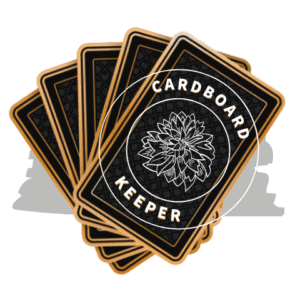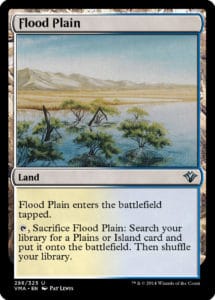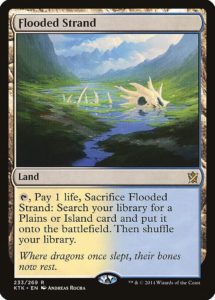Ever since their original printing, Magic The Gathering players haven’t stopped talking about fetch lands. The first time I ever attended Friday Night Magic, someone tried to explain to me what are fetch lands and why I needed to know about them. I didn’t pay much attention at the time, but today, years later, I’ll let you know everything I wish I had known about fetch lands when I first started playing.
As a general rule, Fetch Lands are land cards that can be sacrificed in order to retrieve another land from a player’s deck. There are over 25 lands in Magic The Gathering that are classified as fetch lands. However, only 10 of them are commonly referred to as “Fetch Lands” by Magic players.
That could sound confusing to new Magic The Gathering players, but once you learn just a few important things about fetch lands, you’ll be an expert in no time.
It’s important to have a good understanding of what fetch lands are, and how they work, as it’s practically impossible to play Magic The Gathering at this point and not hear someone mention fetch lands.
The main thing you just need to remember is what makes a fetch land a “fetch land” – The clue is in the name.
All fetch lands, “fetch”.
No matter what type of fetch land we are talking about, at their core, a fetch land is a land in Magic The Gathering that retrieves, or fetches, another land from your deck.
All MTG fetchlands will have some kind of cost associated with activating its ability, typically involving the fetch land sacrificing itself and heading to the graveyard in order to activate its fetch ability.
Each fetch land will have different kinds of cost and restrictions placed upon it that will determine the type, and even the number of lands it can retrieve from your deck once activated.
Some fetch lands are better than others depending on the format that you want to play them in, but there are 10 fetch lands in particular that you need to know about as a Magic player.
Click Here to go straight to the Full List of Fetch Lands in Magic The Gathering
The Main 10 MTG Fetch Lands
Although not the original fetch lands, when Magic The Gathering players normally refer to “The Fetch Lands”, they are often only talking about the 5 fetch lands printed in the “Onslaught” set and the 5 fetch lands printed in the “Zendikar” set.
These are technically not the only fetch lands that exist within Magic The Gathering, but they are the most talked about – and for good reason.
But before we talk about what makes fetch lands so great, it’s important to know which fetch lands we are talking about exactly to help avoid any confusion.
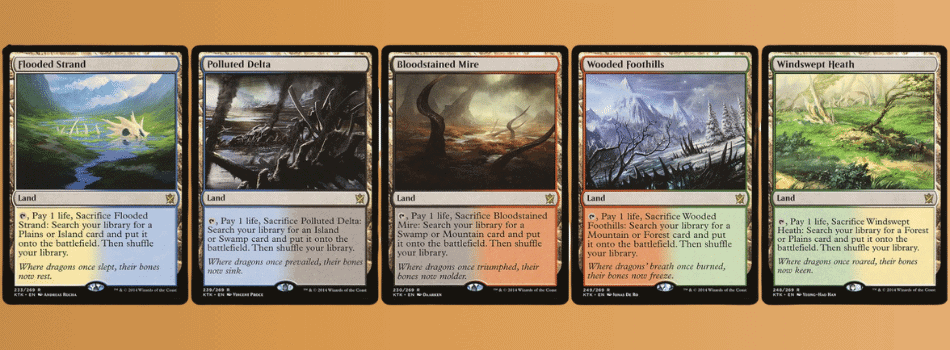
Allied Fetch Lands – Onslaught Fetch Lands
The Onslaught set was released in 2002 and introduced 5 new fetch lands:
| Fetch Land Name | Fetchable Land Types | Mana Association |
|---|---|---|
| Polluted Delta | Island, Swamp | Dimir (Blue, Black) |
| Bloodstained Mire | Swamp, Mountain | Rakdos (Black, Red) |
| Wooded Foothills | Mountain, Forest | Gruul (Red, Green) |
| Windswept Heath | Forest, Plains | Selesnya (Green, White) |
| Flooded Strand | Plains, Island | Azorius (White, Blue) |
Unlike some of the fetch lands I’ll talk about, these come into play untapped, but you need to pay 1 life in order to sacrifice and activate them.
In addition, they can only get you an “allied color” land from its pre-assigned pair. Allied color, refers to color pairings in Magic The Gathering that are considered naturally synergistic with one another.
For example, red and black (Also known as “Rakdos“).
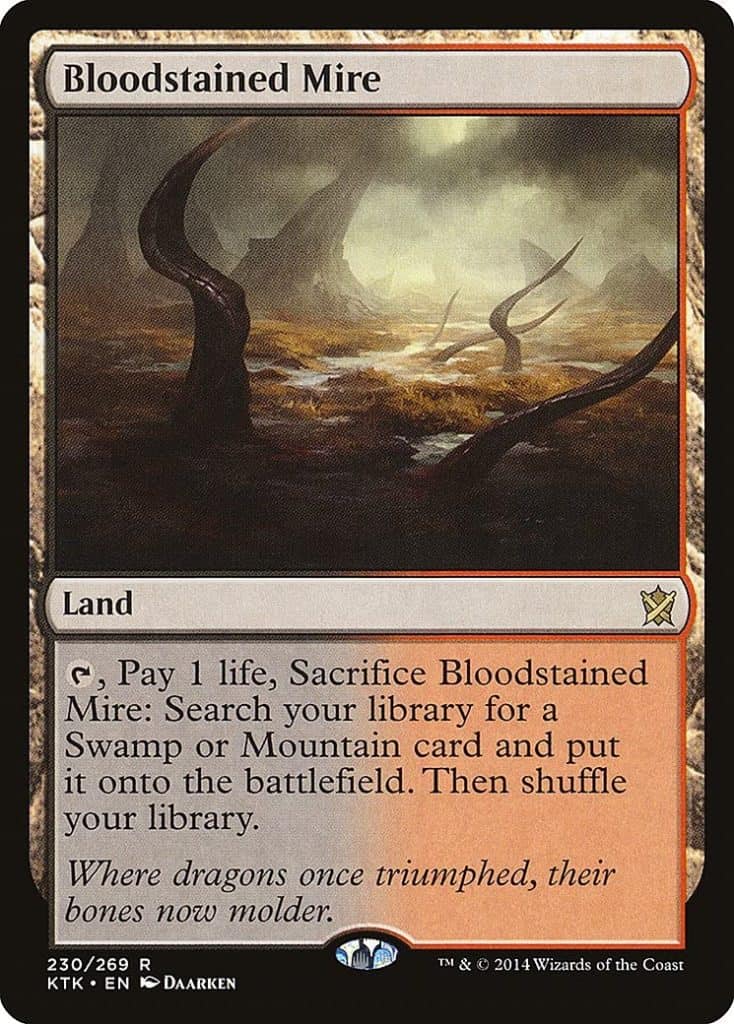
Tap, Pay 1 life, Sacrifice Bloodstained Mire: Search your library for a Swamp or Mountain card, put it onto the battlefield, then shuffle.
Wizards of the Coast – Gatherer[1]
The cool part about these fetch lands is that the land they get comes into play untapped once it’s fetched!
Why would you ever want to spend 1 life to get a land?
It might not seem like a good deal at first glance, but it actually can be very advantageous. If you’re using more than one type of mana and get unlucky with colors of lands coming off the top of your deck, then fetch lands could save your day.
Missing 2 out of 3 colors of mana you need for your deck to function can spell disaster, especially for early game strategies.
What’s worse?
Paying 1 point of life to get the mana you need and start slinging spells at your opponent, or getting stuck for a few turns and giving your opponent all the time in the world to prepare against you?
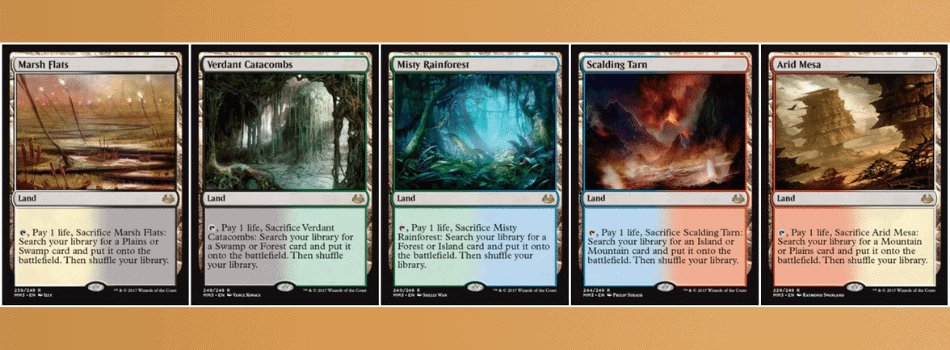
Enemy Fetch Lands – Zendikar Fetch Lands
The previous 5 fetch lands were a hit with players of Magic: The Gathering and Wizards of the Coast decided to add 5 more in the 2009 “Zendikar” Set.
| Fetch Land Name | Fetchable Land Types | Mana Association |
|---|---|---|
| Marsh Flats | Plains, Swamp | Orzhov (White, Black) |
| Scalding Tarn | Island, Mountain | Izzet (Blue, Red) |
| Misty Rainforest | Island, Forest | Simic (Blue, Green) |
| Verdant Catacombs | Forest, Swamp | Golgari (Green, Black) |
| Arid Mesa | Plains, Mountain | Boros (White, Red) |
These enemy-color “fetch lands” (“enemy fetchlands”) were created to complete the set of every combination of two colors in Magic, now having a fetch land to represent it.
2 color combinations within Magic The Gathering are often referred to by the symbol or the name of the “Ravnic Guild” that shares the color identity of those 2 colors. Enemy-color pairings sit across from each other on Magic’s “Color Pie” whereas, Allied colors sit next to each other.
Here is a visual representation of Magic’s Color Pie along with the symbols of the Ravnica Guilds that are used to describe which fetch land is associated with each color combination.
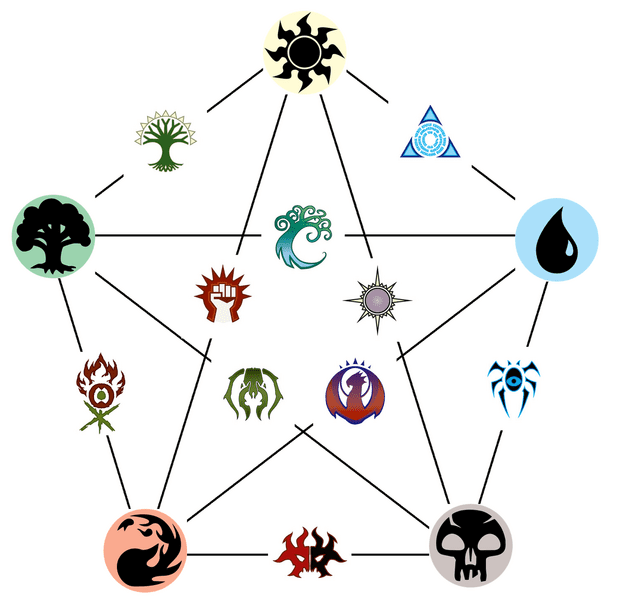
Zendikar’s 5 fetch lands quickly became popular among MTG players and their status has not diminished since.
However, these lands aren’t just great for allowing players better control over their mana bases.
Multicolor decks can reap powerful additional rewards from utilizing these fetch lands.
Fetch lands, while some might argue that they are not inherently advantageous to use if your deck’s mana doesn’t require them, they still have enough versatility to their use cases that it is hard to escape them.
Despite their expensive cost, they are incredibly versatile in decks that are built around certain strategies.
If you are interested in all the benefits that can come from having fetch lands in your deck, check my full post on the benefits of fetch lands in competitive decks – “Why Are Fetchlands Good? Magic The Gathering [Helpful Guide]”
The 10 fetch lands mentioned above are normally what most Magic players refer to when talking about “fetch lands”, however, these 10 lands are not the only fetch lands that exist within the game.
Although they are the most prevalent lands you will see played in Magic’s older competitive formats, they were not the first fetch lands that printed into the game of Magic The Gathering.
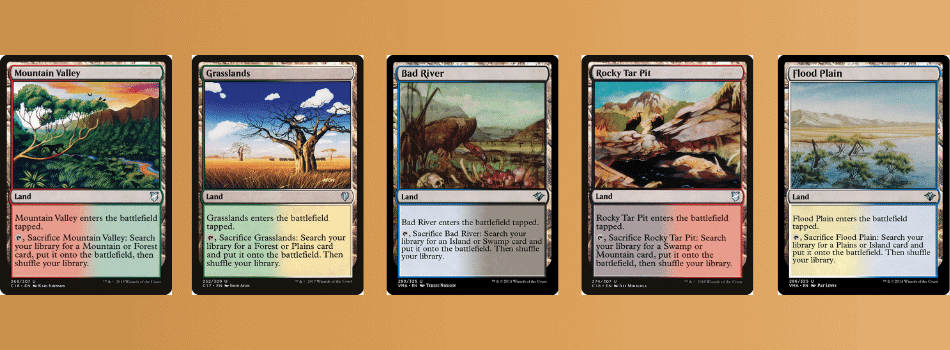
Slow Fetch Lands – Mirage Fetch lands
Mirage was the first set to feature fetch lands when it was released in 1996.
The original 5 fetch lands this set featured were:
| Fetch Land Name | Fetchable Land Types | Mana Association |
|---|---|---|
| Bad River | Island, Swamp | Dimir (Blue, Black) |
| Rocky Tar Pit | Swamp, Mountain | Rakdos (Black, Red) |
| Mountain Valley | Mountain, Forest | Gruul (Red, Green) |
| Grasslands | Forest, Plains | Selesnya (Green, White) |
| Flood Plain | Plains, Island | Azorius (White, Blue) |
“Fetch Lands” became an interesting new addition to the “Magic The Gathering” card game and these 5 cards soon became very popular.
Players found them useful for fixing their mana problems at the time, which in turn introduced players to a new way of managing the mana of multicolored decks more effectively.
However, the original “fetch lands” had a downside, they came into play tapped, meaning that you had to wait until it was your next turn before you could use your land.
This can be costly in a game because it may result in you, effectively, giving up your turn and missing out on making trades and controlling the board early on.
Sometimes in a game of Magic The Gathering you don’t get a “next turn“.
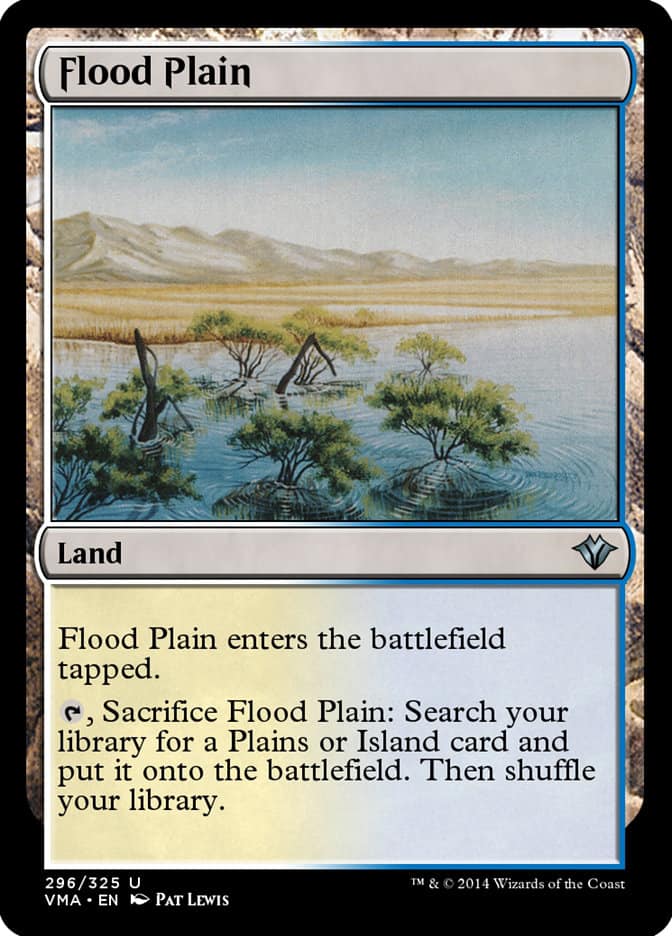
Flood Plain enters the battlefield tapped.
Tap, Sacrifice Flood Plain: Search your library for a Plains or Island card, put it onto the battlefield, then shuffle.
Wizards of the Coast – Gatherer[2]
With the release of the newer fetch lands that don’t come into play tapped and can be used right away, these original fetch lands earned themselves the nickname “slow-fetches” from Magic players.
They were popular when they were originally released, but now you’ll normally only see these original fetches, the “slow-fetches,” in budget decks or singleton formats like Commander.
They have still maintained a level of relevance for Magic The Gathering players simply due to the fact that they act as a cheaper alternative to the newer fetch lands for less competitive Magic formats.
The cost of the 10 most popular fetch lands are at a high premium and many players can’t afford to buy complete playsets of them.
If you want to know why the price of fetch lands is so high, you can read about the answer in my post where I do a breakdown of the reasons fetch lands cost so much – “Why Are Fetchlands So Expensive? Magic The Gathering Guide”
Although no longer popular as they once were, these fetch lands are worth remembering and adding to your collection as they represent a significant turning point in Magic’s card game history.
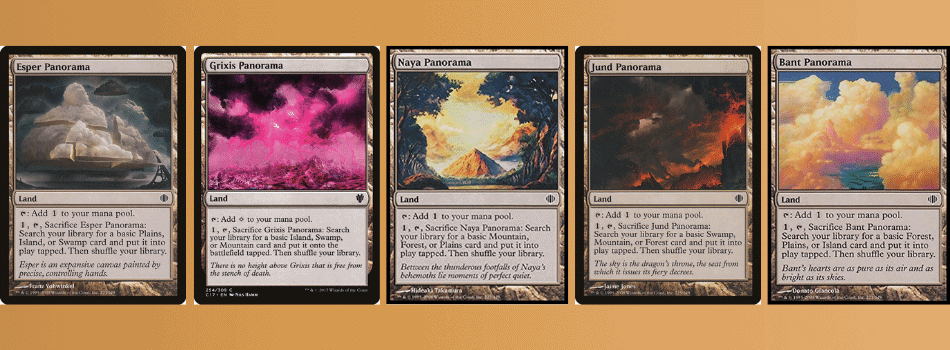
Panorama Fetch Lands – Shards of Alara
In 2008, the set “Shards of Alara” was released and featured a set of fetches that would commonly become known as the “Panoramas” by Magic The Gathering players[4].
The Panoramas enter play untapped and, unlike the previously mentioned fetch lands, can also be used to produce colorless mana without having to use their fetch ability.
Although often not referred to as a fetch land, these 5 fetch lands were themed around 3 color combinations that are known as “Shards“.
| Fetch Land Name | Fetchable Basic Land Types | Mana Association |
|---|---|---|
| Bant Panorama | Island, Forest, Plains | Bant (Blue, Green, White) |
| Esper Panorama | Swamp, Plains, Island | Esper (Black, White, Blue) |
| Grixis Panorama | Mountain, Swamp, Island | Grixis (Red, Black, Blue) |
| Jund Panorama | Forest, Mountain, Swamp | Jund (Green, Red, Black) |
| Naya Panorama | Plains, Mountain, Forest | Naya (White, Green, Red) |
If the Panoramas can get 3 different types of lands and produce mana of their own, why aren’t these the most popular fetch lands?
The devil is in the details.
The Panoramas have some serious downsides that cause them to see next to no competitive play in Magic The Gathering formats.
Although the Panoramas do not make you pay 1 life to activate them, like the most popular fetch lands do, Panoramas do make you pay 1 mana to activate them instead.
This means if it’s the first turn of the game, and you play a Panorama, you won’t be able to activate its fetch ability to get a Land from your deck, as you don’t have extra mana to pay for the activation cost.
Game Rules: You can not simultaneously tap a Panorama to produce colorless mana and activate its fetch ability – You can only choose one!
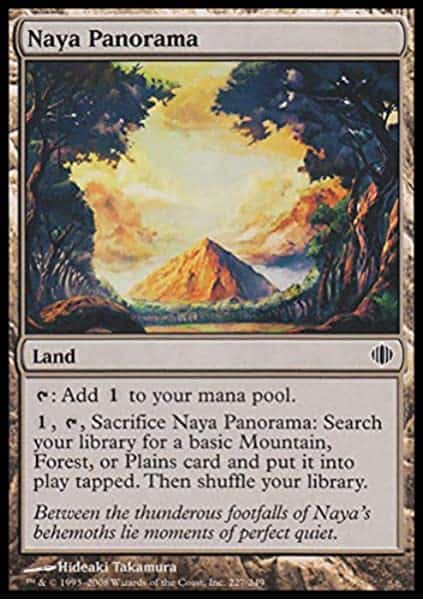
Tap: Add 1.
Wizards of the Coast – Gatherer[3]
1, Tap, Sacrifice Naya Panorama: Search your library for a basic Mountain, Forest, or Plains card, put it onto the battlefield tapped, then shuffle.
Arguably the biggest downside to using a Panorama is that they are only able to fetch basic lands.
Unlike the other fetch lands we have mentioned up until this point, a Panorama can only get a Land that has the word “basic” in its subtype and matches one of the predefined land types.
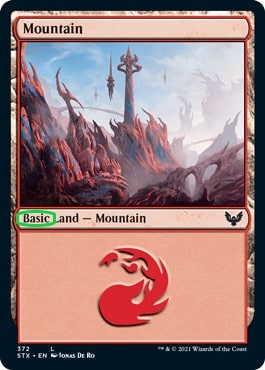
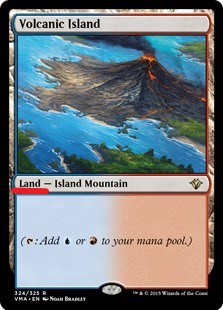
This makes Panoramas considerably weaker than previously mentioned fetch lands as, typically, Basic Lands can only ever produce one color of mana and the option to fetch for Dual Lands (non-basic lands) is not available.
Although often considered an inferior fetch land, these Panoramas still see play in less competitive formats and singleton formats such as Commander.
Comparison Table
| Fetch Land Type | Activation Cost | Fetchable Land Types | Enters Play |
|---|---|---|---|
| “The Fetch Lands“ | Tap + 1 Life | 2 | Untapped |
| “Slow Fetches“ | Tap | 2 | Tapped |
| “Panoramas“ | Tap + 1 Mana | 3 (Basic Only) | Untapped |
The Problem With All Fetch Lands
Besides their prohibitive cost of the “The Fetch lands“, one of the biggest problems Magic The Gathering players often complain about when using a physical deck and fetch lands, is the constant need to shuffle their deck.
When 5 of the most popular fetches were reprinted into Standard for the set “Khans of Tarkir”, nearly every deck had the Khans of Tarkir fetch lands in them.
A lot of Magic matches end up spending half their games searching for land cards, or worse yet, many games ended in draws due to players wasting so much time on shuffling and running out of time on the match clock.
However, the problem with fetch lands is they’re too useful to give up. You’ll end up using them either way if all your opponents have them in their decks. Otherwise, you’ll be at a serious disadvantage.
The team behind developing Magic The Gathering have officially stated that they don’t like the types of games fetch lands produce when legal in Magic’s Standard format, after seeing what they did during the fetchland reprint into the Khans of Tarkir Standard format.
Since reprints are needed to keep the prices of high-demand cards like the fetch lands under control, there is concern within the Magic community that the prices of fetch lands will slowly spiral out of control and become inaccessible to new players without reprints.
If you are interested in the future of reprints for fetch lands then you may want to check out my post, where I break down official statements from Wizards of the Coast staff members, to see what we can expect from reprints going forward – “Will Fetch Lands Be Reprinted? (Everything We Know)”
Other MTG Fetch Lands
Magic The Gathering has over 25 fetch lands within its huge card pool and the game regularly adds more.
Although not all fetch lands are created equal, depending on what Magic formats you like to play you may find that some of the other fetch lands printed into the game are of more interest to you then the ones above.
While every fetch land gets lands from your deck in some fashion, that’s what makes it a fetch, some do this in more interesting ways than others.
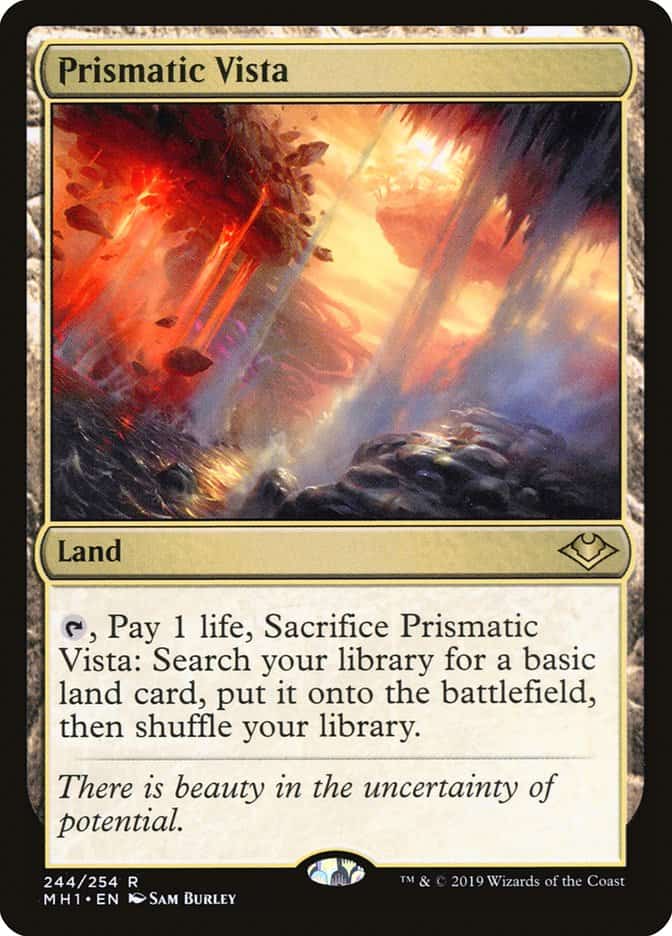
Prismatic Vista
Often thought of as the honorary 11th “Fetch Land”, Prismatic Vista works in almost an identical way to the 10 most popular fetch lands in Magic The Gathering by requiring you to “Pay 1 Life” to fetch a land from your deck.
Unfortunately, it doesn’t make the cut as one of Magic’s most powerful fetch land as the card limits you to only fetching Basic Lands from your deck.
It can still be a great alternative to the other fetch lands if you don’t have access to them and need a better way to manage multiple colors of mana in your deck.
However, while seeing some competitive play, Prismatic Vista is played far less when compared to more popular fetch lands.
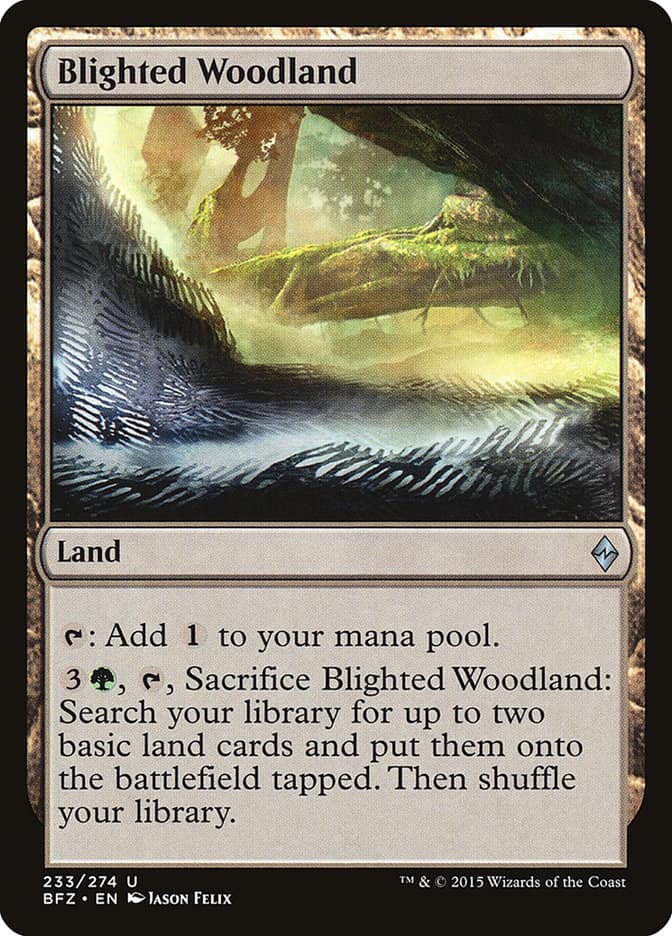
Blighted Woodland
The fetch land that helps you ramp.
Although it doesn’t see that much competitive play anymore, this land has been know to show up in ramp decks during its time in Standard. The land can provide some basic utility by being able to produce mana by itself – although the mana is colorless.
Where this land shines is that it can ramp green decks as soon as turn 5, from 5 mana to 7 mana.
The land sacrifices itself to go get 2 basic Forests from your deck and puts them straight onto the battlefield. You will have to give up your entire 5th turn to do this since activating Blighted Woodland will use up all of your mana.
Since it can only get basic Forests, it’s not good for color fixing in decks that are playing a lot of colors, but it can be great in a game of Commander if you are trying to play your “Ugin, the Spirit Dragon” before anyone expects you to.
List of MTG Fetch Lands
| Fetch Land | Fetch Land Type |
|---|---|
| Bad River | “Slow Fetch” |
| Rocky Tar Pit | “Slow Fetch” |
| Mountain Valley | “Slow Fetch” |
| Grasslands | “Slow Fetch” |
| Flood Plain | “Slow Fetch” |
| Flooded Strand | “Fetch Land” |
| Polluted Delta | “Fetch Land” |
| Bloodstained Mire | “Fetch Land” |
| Wooded Foothills | “Fetch Land” |
| Windswept Heath | “Fetch Land” |
| Marsh Flats | “Fetch Land” |
| Scalding Tarn | “Fetch Land” |
| Verdant Catacombs | “Fetch Land” |
| Arid Mesa | “Fetch Land” |
| Misty Rainforest | “Fetch Land” |
| Bant Panorama | “Panorama” |
| Esper Panorama | “Panorama” |
| Grixis Panorama | “Panorama” |
| Jund Panorama | “Panorama” |
| Naya Panorama | “Panorama” |
| Blighted Woodland | Miscellaneous |
| Fabled Passage | Miscellaneous |
| Flagstones of Trokair | Miscellaneous |
| Krosan Verge | Miscellaneous |
| Maze’s End | Miscellaneous |
| Prismatic Vista | Miscellaneous |
| Terminal Moraine | Miscellaneous |
| Warped Landscape | Miscellaneous |
| Evolving Wilds | Miscellaneous |
| Terramorphic Expanse | Miscellaneous |
| Thawing Glaciers | Miscellaneous |
| Myriad Landscape | Miscellaneous |
Fetch Lands see play in almost every Magic The Gathering format there is, and that isn’t by chance.
Competitive players have long come to recognize the benefits that fetch lands bring to decks and have been built with them in mind ever since they were released.
Although the naming sense of fetch lands may be a little confusing to get your head around when you first start playing Magic, you will hear fetch lands referred to so often that you will soon pick it up yourself.
If you are looking for further insights into when the best time to pick up a playest of fetch lands is, you can check out my post where I breakdown when buying fetch lands will save you the most amount of money – When To Buy Fetchlands: What You Should Know
